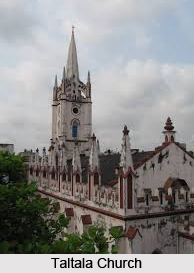 Taltala is now an urban conglomeration area located in central part of Kolkata in the Indian state of West Bengal. Now Taltala is one of the old neighbourhoods of the metropolis with all the favourable amenities. The attractions of Taltala are the British architectures and the Bengali Zamindar houses styled with Gothic architecture that were famous in 18th century Bengal.
Taltala is now an urban conglomeration area located in central part of Kolkata in the Indian state of West Bengal. Now Taltala is one of the old neighbourhoods of the metropolis with all the favourable amenities. The attractions of Taltala are the British architectures and the Bengali Zamindar houses styled with Gothic architecture that were famous in 18th century Bengal.
Location of Taltala
Taltala is located in the Central part of Kolkata. Taltala was named after its tal trees.
History of Taltala
History of Taltala defines that according to H. E. A. Cotton, a British historian, Taltala was chiefly peopled by Bihari Muslim khalasis and lascars. Wellesley Street was renamed Rafi Ahmed Kidwai Road and it is described as a fine broad thoroughfare, along the course of which is situated Wellesley Square (renamed Haji Mohd. Mohsin Square).
In 1758, one year after the wining in Battle of Plassey (1757) that led the war against the independent ruler of Bengal, Siraj-ud-daulah and the British East India Company. The British East India Company commenced construction of the new Fort William in the centre of the village Gobindapur. The inhabitants of Gobindapur were compensated and provided with land in Taltala, Kumortuli and Shovabazar. Later in the modern era, Taltala eye witnesses the zamindari era in the midst of Kolkata and the torture done by the police of British Government in India and the zamindars of Kolkata to the lascars of Kolkata, who were the labour-class people of that time. The place was largely dominated by Muslims. The early Hindu settlers included Durga Charan Banerjee, father of Surendranath Banerjee, prominent residents in modern Renaissance Kolkata. Now, Muslims have been living in the area since the early 19th century, and the earliest inhabitants were mainly Bengali Muslims, though Bihari Muslim settlers began arriving in a flood since 1870-1880 and more so since the 1980s.
Administration of Taltala
Taltala is now in the ward no. 62, broadly under Park Street Police Station but a part of it is under Taltala police station. The neighbourhood of Taltala is bound by Dharmatala in the north, Entally in the east, Park Street neighbourhood in the south and Janbazar and Chowringhee in the west.
Population in Taltala
According to the Population census in 2001, there are 24,121 males and 19,227 females. Ward No. 62 had a population of 45,817, out of which 28,019 were males and 17,798 were females. The locality is largely Urdu-speaking. Urdu-speaking Muslims form 85% of the population.
Related Articles
Capital Cities of India
Kolkata
Tourism in Kolkata
Battle of Plassey
Kolkata, Indian City, West Bengal
Culture of Kolkata
History of Kolkata
Monuments in Kolkata
British Monuments in Kolkata



















